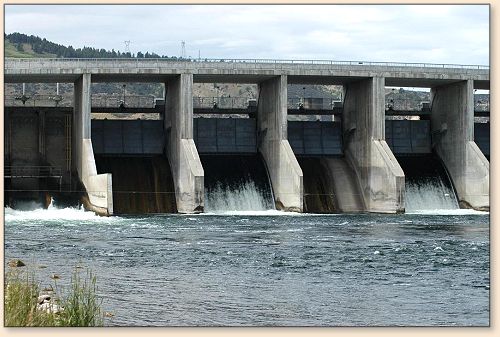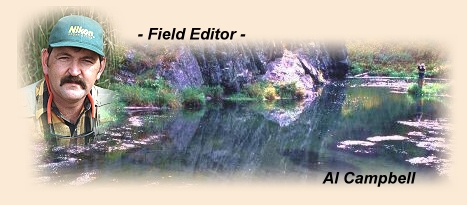|
When I'm on a river far from home, I stop in
at least one fly shop to buy licenses and some
local patterns. I often visit them all, especially
if I'm new to the area, but there is always one
place where I spend some cash, even though it's
often small. On the Bighorn River, that place
is the Bighorn Trout Shop. I know the place,
several of their guides are friends, they have
always treated me well, and to top it off, they
are sponsors here on FAOL.
I often take my fly tying stuff to the river. In
fact, this is the first year I didn't have it along.
I figured I probably have enough of anything real
important to get me by. To top it off, there is
always the Bighorn Trout Shop. So, here I am in
the shop buying licenses, looking stuff over and
shooting the breeze, when I spot this large pile
of flies in boxes. They were baetis midges and pupae,
and each dozen was just $7.00. I asked about them
and some young guy told me they were a special buy,
but they worked fine. I'm not totally sure I believe
his story, but I do know that there are baetis midges
in the river at that time, and I don't care to tie up
the adults, so I bought a dozen of each. We picked
up a few other goodies our local guide friend told
us about and went to the river.
Backing up a bit, Erik and I stopped at the river
the first night we were there to just look things
over. When we got there, there were hundreds or
rises all over the place. I don't mean just a few,
I mean hundreds, but nobody was fishing them. So,
I asked my guide friend later that evening what
those fish were. He said they were trout, but
mostly small ones. OK, I can fish small trout.
That is especially true when the river is low
and some folks are harping about low catch numbers.
I'm also aware that there are large fish among the
small ones, so this shouldn't be a bad thing. I
asked my friend why they didn't guide that stretch,
and just got the smile, which means it isn't a place
to guide, if you know what I mean. However, that
doesn't mean I can't fish it.
On that first fishing day, I rigged up two nymphs,
no weight, and a strike indicator up about 8 feet
above the flies. There are several reasons I do
this. First, my eyes are getting old, so having
something like an indicator on a big river can be
helpful. Second, I like to let my stuff drift, so
an indicator makes that easier. And, (this is the
most important) to anyone looking at what I'm using,
it looks like I have a standard weighted nymph rig
like everyone else throws on that river. No sense
giving it all up without a fight now is there;
nobody ever knows what I'm using unless I tell
them.
The top fly I used was the baetis nymph I bought
at the fly shop. It actually caught about 30 fish
per day too. However, the bottom fly was the killer,
and I usually changed it three times per day. The
fish will tell you if you're using the wrong fly
by not biting on every cast. However, my casts
aren't like most people cast. I stand in the water
and cast out and down, then follow the indicator
until it has settled into the slack water below me.
Most of the time, I had very little action until
the fly had settled into the slow water. Then, I
would twitch the rod tip slightly and allow the
line to travel toward the bank and if needed,
back out toward the middle. It usually took
less than two feet of travel to get a hit.
The first fly I used on the bottom of my string
was a red baetis nymph, sizes 18 to 22, tied with
red lace (your choice) and a red bead right behind
the eye. By red, I mean real, bright red; the kind
of color you might want on the tip of a cattle prod.
The brighter and redder it was, the better the
results were. If you want a visual, check out
this link.
All you need to do is add a red bead and make the
color as red as possible. This is always one of
my favorite Bighorn flies.
When the fish slow down on that fly, I replace it
with a Fall Midge Emerger. Here is a visual for
that fly.
I tie it in sizes 18 to 22, and usually use mink
hair for the body, horsehair for the rib and pine
squirrel hair for the wing. It only works for an
hour or so, but that time can be grand.
The third fly I used, and the one I used the most
was a Too Simple Ray Charles. Here is a link for that
fly.
I tie it in sizes 14 to 18, and use the brightest
red thread I can find for the head. I rib mine
with gold wire for durability, but other than
that, it is the same as I showed here in that
article. More than once I had a fish on that
managed to get off, and hooked another before
I could cast again. It is a killer, if used right.
One last thing; I'm going to repeat the way I
fished those flies one more time. It is very
important that you follow these rules if you
want to get the best fishing out of it. Cast
downstream, and fish the slack water below you.
You will catch more fish less than three feet
from the bank that you will in the swift current.
Don't use weight on your line. NONE!!! The fish
are picking off emergers in that slack water and
they are feeding just under the surface. Weight
will drop the flies too low to be effective.
And, stay near the place where the boats are put
in below the Afterbay Dam. If you move as slowly
as I do, you might get half a mile downstream in
one day, if you are in a hurry.

I'm fully aware that maybe one in ten will actually
try this, but those guys will have a great time.
The rest of you can have all the fun you want with
the other guys downstream. Next week, I will show
more of the water and how crowded it really can get.
~ AC
|


